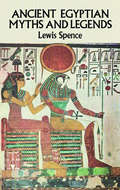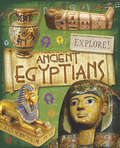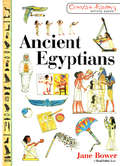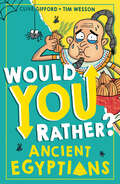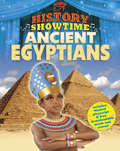- Table View
- List View
Ancient Egyptian Myths and Legends
by Lewis Spence"Let us walk in the gloom of the pyramids, in the cool shadows of ruined temples, aye, through the tortuous labyrinth of the Egyptian mind itself, trusting that by virtue of the light we carry we shall succeed in unravelling to some extent the age-long enigma of this mystic land." — from Chapter One.In this classic study, a noted mythologist made perhaps the first serious attempt to review the religious history of ancient Egypt in the light of the science of modern mythology. Instead of regarding Egyptian mythology and legend as unique, "classic" and inviolate, as did many Egyptologists, Spence saw Egyptian religious thought as part of world mythology, rooted in primitive conceptions common to mankind as a whole and related to those of many other cultures. In supporting this thesis, Spence offers an immensely erudite in-depth survey of the broad spectrum of Egyptian gods and goddesses, cults, and beliefs, as well as a concise review of Egyptian history, manners, customs, and archaeology.Animism, totemism, fetishism, creation myths, and other aspects of early religious beliefs are explored in an introductory chapter. The author then goes on to discuss the Egyptian priesthood, mysteries and temples, the cult of Osiris; Ra the Sun-God, Anubis, Horus, Thoth, and numerous other deities; the Book of the Dead, the birth of Hatshepsut, sacred trees, alchemy, the festival of Bast, Egyptian art, magic, and amulets, legends; and a host of other topics.Enhanced with over 50 photographs and illustrations, this book belongs in the library of any student of ancient Egypt or of early man's attempts, through mythology and legend, to give order, meaning, and purpose to his world.
Ancient Egyptian Scribes: A Cultural Exploration (Bloomsbury Egyptology)
by Niv Allon Hana NavratilovaThe modern view of the ancient Egyptian world is often through the lens of a scribe: the trained, schooled, literate individual who was present at many levels of Egyptian society, from a local accountant to the highest echelons of society. And yet, despite the wealth of information the scribes left us, we know relatively little about what underpinned their world, about their mentality and about their everyday life. Tracing ten key biographies, Ancient Egyptian Scribes examines how these figures kept both the administrative life and cultural memory of Egypt running. These are the Egyptians who ran the state and formed the supposedly meritocratic system of local administration and government. Case studies look at accountants, draughtsmen, scribes with military and dynastic roles, the authors of graffiti and literati who interacted in different ways with Pharaohs and other leaders. Assuming no previous knowledge of ancient Egypt, the various roles and identities of the scribes are presented in a concise and accessible way, offering structured information on their cultural identity and self-presentation, and providing readers with an insight into the making of Egyptian written culture.
Ancient Egyptian Scribes: A Cultural Exploration (Bloomsbury Egyptology)
by Niv Allon Hana NavratilovaThe modern view of the ancient Egyptian world is often through the lens of a scribe: the trained, schooled, literate individual who was present at many levels of Egyptian society, from a local accountant to the highest echelons of society. And yet, despite the wealth of information the scribes left us, we know relatively little about what underpinned their world, about their mentality and about their everyday life. Tracing ten key biographies, Ancient Egyptian Scribes examines how these figures kept both the administrative life and cultural memory of Egypt running. These are the Egyptians who ran the state and formed the supposedly meritocratic system of local administration and government. Case studies look at accountants, draughtsmen, scribes with military and dynastic roles, the authors of graffiti and literati who interacted in different ways with Pharaohs and other leaders. Assuming no previous knowledge of ancient Egypt, the various roles and identities of the scribes are presented in a concise and accessible way, offering structured information on their cultural identity and self-presentation, and providing readers with an insight into the making of Egyptian written culture.
Ancient Egyptian Society: Challenging Assumptions, Exploring Approaches
by Danielle Candelora Nadia Ben-Marzouk Kathlyn M. CooneyThis volume challenges assumptions about—and highlights new approaches to—the study of ancient Egyptian society by tackling various thematic social issues through structured individual case studies. The reader will be presented with questions about the relevance of the past in the present. The chapters encourage an understanding of Egypt in its own terms through the lens of power, people, and place, offering a more nuanced understanding of the way Egyptian society was organized and illustrating the benefits of new approaches to topics in need of a critical re-examination. By re-evaluating traditional, long-held beliefs about a monolithic, unchanging ancient Egyptian society, this volume writes a new narrative—one unchecked assumption at a time. Ancient Egyptian Society: Challenging Assumptions, Exploring Approaches is intended for anyone studying ancient Egypt or ancient societies more broadly, including undergraduate and graduate students, Egyptologists, and scholars in adjacent fields.
Ancient Egyptian Society: Challenging Assumptions, Exploring Approaches
by Danielle Candelora Nadia Ben-Marzouk Kathlyn M. CooneyThis volume challenges assumptions about—and highlights new approaches to—the study of ancient Egyptian society by tackling various thematic social issues through structured individual case studies. The reader will be presented with questions about the relevance of the past in the present. The chapters encourage an understanding of Egypt in its own terms through the lens of power, people, and place, offering a more nuanced understanding of the way Egyptian society was organized and illustrating the benefits of new approaches to topics in need of a critical re-examination. By re-evaluating traditional, long-held beliefs about a monolithic, unchanging ancient Egyptian society, this volume writes a new narrative—one unchecked assumption at a time. Ancient Egyptian Society: Challenging Assumptions, Exploring Approaches is intended for anyone studying ancient Egypt or ancient societies more broadly, including undergraduate and graduate students, Egyptologists, and scholars in adjacent fields.
An Ancient Egyptian tomb (large print)
by RnibThis is image is a plan view of a typical Egyptian tomb showing an annexe, a treasure room, antechamber and burial chamber. There is a locator dot shown, which will be at the top left of the page when the image is the right way up. The plan is bounded by a dashed line image border. On the bottom left of the page is the entrance into an antechamber filled with treasures and artefacts. At the top left of the page is an annexe with more valuable objects. At the right side of the antechamber there are two statues of the king and to the right of these is the entrance to the burial chamber containing the coffin. The wall to the right of the coffin is decorated. At the bottom right of the page is a treasure room with a golden shrine and an image of Anubis, god of the funeral cult and carer for the dead.
An Ancient Egyptian tomb (UEB contracted)
by RnibThis is image is a plan view of a typical Egyptian tomb showing an annexe, a treasure room, antechamber and burial chamber. There is a locator dot shown, which will be at the top left of the page when the image is the right way up. The plan is bounded by a dashed line image border. On the bottom left of the page is the entrance into an antechamber filled with treasures and artefacts. At the top left of the page is an annexe with more valuable objects. At the right side of the antechamber there are two statues of the king and to the right of these is the entrance to the burial chamber containing the coffin. The wall to the right of the coffin is decorated. At the bottom right of the page is a treasure room with a golden shrine and an image of Anubis, god of the funeral cult and carer for the dead.
An Ancient Egyptian tomb (UEB uncontracted)
by RnibThis is image is a plan view of a typical Egyptian tomb showing an annexe, a treasure room, antechamber and burial chamber. There is a locator dot shown, which will be at the top left of the page when the image is the right way up. The plan is bounded by a dashed line image border. On the bottom left of the page is the entrance into an antechamber filled with treasures and artefacts. At the top left of the page is an annexe with more valuable objects. At the right side of the antechamber there are two statues of the king and to the right of these is the entrance to the burial chamber containing the coffin. The wall to the right of the coffin is decorated. At the bottom right of the page is a treasure room with a golden shrine and an image of Anubis, god of the funeral cult and carer for the dead.
Ancient Egyptian Tombs: The Culture of Life and Death (Blackwell Ancient Religions Ser. #14)
by Steven SnapeThis book explores the development of tombs as a cultural phenomenon in ancient Egypt and examines what tombs reveal about ancient Egyptian culture and Egyptians’ belief in the afterlife. Investigates the roles of tombs in the development of funerary practices Draws on a range of data, including architecture, artifacts and texts Discusses tombs within the context of everyday life in Ancient Egypt Stresses the importance of the tomb as an eternal expression of the self
Ancient Egyptian Tombs: The Culture of Life and Death
by Steven SnapeThis book explores the development of tombs as a cultural phenomenon in ancient Egypt and examines what tombs reveal about ancient Egyptian culture and Egyptians’ belief in the afterlife. Investigates the roles of tombs in the development of funerary practices Draws on a range of data, including architecture, artifacts and texts Discusses tombs within the context of everyday life in Ancient Egypt Stresses the importance of the tomb as an eternal expression of the self
Ancient Egyptians: Egyptians (Explore! #12)
by Jane BinghamThis photographic book gives you an overview of Ancient Egyptians. From the early kingdoms to the mighty pharaohs that led the Eqyptian world. Learn about Egyptian religion and beliefs, life for ordinary people and the brilliant buildings. We also look at the food, medicine, science, music and art of the time. You can read about a day at temple school and learn to write in hieroglyphics.
Ancient Egyptians
by Jane BowerThis innovative series is designed to help teachers bring history topics to life through imaginative creative arts activities. Each pack includes 10 laminated, double-sided cards, printed in full color. Every card describes in detail activities that recreate aspects of life in a particular historical period, using art, drama and dance. All activities are based on historically researched authentic practices of the time. Ideal for whole class or small group sessions, the packs are an inspiration for busy teachers looking for new ways to approach project work at Key Stage 2 - and can also easily be used with Key Stage 1 classes. Ancient Egyptian activities in this pack include using clay to create artifacts: the Game of Snake, soul houses and canopic jars; recreating rituals through drama: the Apprentice Embalmer and Weighing the Heart; making tomb paintings and bas relief; making shell jewelry, scarab rings and amulets; and creating a dance for the Festival of the Nile.
Ancient Egyptians
by Jane BowerThis innovative series is designed to help teachers bring history topics to life through imaginative creative arts activities. Each pack includes 10 laminated, double-sided cards, printed in full color. Every card describes in detail activities that recreate aspects of life in a particular historical period, using art, drama and dance. All activities are based on historically researched authentic practices of the time. Ideal for whole class or small group sessions, the packs are an inspiration for busy teachers looking for new ways to approach project work at Key Stage 2 - and can also easily be used with Key Stage 1 classes. Ancient Egyptian activities in this pack include using clay to create artifacts: the Game of Snake, soul houses and canopic jars; recreating rituals through drama: the Apprentice Embalmer and Weighing the Heart; making tomb paintings and bas relief; making shell jewelry, scarab rings and amulets; and creating a dance for the Festival of the Nile.
Ancient Egyptians (Would You Rather?)
by Clive GiffordWould you rather be a pharaoh or a pharaoh’s servant? Cleopatra or Queen Hatshepsut? Only you can decide!
Ancient Egyptians (What They Don't Tell You About)
by David JayDid you know that Egyptian policemen used monkeys to arrest people?The Ancient Egyptians lived half of their lives up to their eyes in mud, the other half choking on desert sand, and spent most of their time thinking about dying! Any history book will give you the boring facts THEY think you should know, but only this one will tell you just how weird life in Ancient Egypt REALLY was ...
Ancient Egyptians (History Showtime #1)
by Liza Phipps Avril ThompsonHistory Showtime brings a fresh new approach to history, combining essential learning with the fun of drama and music.History Showtime: Ancient Egyptians looks at who the ancient Egyptians were and describes their everyday life, such as what they ate, what they wore and their beliefs. Alongside this key information are four songs, unique to this series, which bring the facts to life. At the end of the book is a simple playscript for children to act out which explores the famous opening of Tutankhamun's tomb.
Ancient Egyptians at Play: Board Games Across Borders (Bloomsbury Egyptology)
by Walter Crist Anne-Elizabeth Dunn-Vaturi Alex De VoogtThe rich history of Egypt has provided famous examples of board games played in antiquity. Each of these games provides evidence of contact between Egypt and its neighbours. From pre-dynastic rule to Arab and Ottoman invasions, Egypt's past is visible on game boards. This volume starts by introducing the reader to board games as well as instruments of chance and goes on to trace the history and distribution of ancient Egyptian games, looking particularly at how they show contact with other cultures and civilizations. Game practices, which were also part of Egyptian rituals and divination, travelled throughout the eastern Mediterranean. This book explores the role of Egypt in accepting and disseminating games during its long history. Over the last few years, the extent and the modes of contact have become better understood through museum and archival research projects as well as surveys of archaeological sites in Egypt and its surrounding regions. The results allow new insight into ancient Egypt's international relations and the role of board games research in understanding its extent.Written by three authors known internationally for their expertise on this topic, this will be the first volume on Ancient Egyptian games of its kind and a much-needed contribution to the field of both Egyptology and board games studies.
Ancient Egyptians at Play: Board Games Across Borders (Bloomsbury Egyptology)
by Walter Crist Anne-Elizabeth Dunn-Vaturi Alex De VoogtThe rich history of Egypt has provided famous examples of board games played in antiquity. Each of these games provides evidence of contact between Egypt and its neighbours. From pre-dynastic rule to Arab and Ottoman invasions, Egypt's past is visible on game boards. This volume starts by introducing the reader to board games as well as instruments of chance and goes on to trace the history and distribution of ancient Egyptian games, looking particularly at how they show contact with other cultures and civilizations. Game practices, which were also part of Egyptian rituals and divination, travelled throughout the eastern Mediterranean. This book explores the role of Egypt in accepting and disseminating games during its long history. Over the last few years, the extent and the modes of contact have become better understood through museum and archival research projects as well as surveys of archaeological sites in Egypt and its surrounding regions. The results allow new insight into ancient Egypt's international relations and the role of board games research in understanding its extent.Written by three authors known internationally for their expertise on this topic, this will be the first volume on Ancient Egyptian games of its kind and a much-needed contribution to the field of both Egyptology and board games studies.
The Ancient Egyptians For Dummies
by Charlotte BoothUnravel the history behind of one of the most fascinating ancient civilisations with this engaging, entertaining and educational guide to the ancient Egyptians. With a complete rundown of ancient Egyptian history and culture alongside insights in to the everyday lives of the Egyptians, you’ll discover how they kept themselves entertained, the gory details of mummification, the amazing creation of the pyramids, the deciphering of hieroglyphs and much more.
The Ancient Egyptians For Dummies
by Charlotte BoothUnravel the history behind of one of the most fascinating ancient civilisations with this engaging, entertaining and educational guide to the ancient Egyptians. With a complete rundown of ancient Egyptian history and culture alongside insights in to the everyday lives of the Egyptians, you’ll discover how they kept themselves entertained, the gory details of mummification, the amazing creation of the pyramids, the deciphering of hieroglyphs and much more.
The Ancient Emotion of Disgust (Emotions of the Past)
by Donald Lateiner Dimos SpatharasThe study of emotions and emotional displays has achieved a deserved prominence in recent classical scholarship. The emotions of the classical world can be plumbed to provide a valuable heuristic tool. Emotions can help us understand key issues of ancient ethics, ideological assumptions, and normative behaviors, but, more frequently than not, classical scholars have turned their attention to "social emotions" requiring practical decisions and ethical judgments in public and private gatherings. The emotion of disgust has been unwarrantedly neglected, even though it figures saliently in many literary genres, such as iambic poetry and comedy, historiography, and even tragedy and philosophy. This collection of seventeen essays by fifteen authors features the emotion of disgust as one cutting edge of the study of Greek and Roman antiquity. Individual contributions explore a wide range of topics. These include the semantics of the emotion both in Greek and Latin literature, its social uses as a means of marginalizing individuals or groups of individuals, such as politicians judged deviant or witches, its role in determining aesthetic judgments, and its potentialities as an elicitor of aesthetic pleasure. The papers also discuss the vocabulary and uses of disgust in life (Galli, actors, witches, homosexuals) and in many literary genres: ancient theater, oratory, satire, poetry, medicine, historiography, Hellenistic didactic and fable, and the Roman novel. The Introduction addresses key methodological issues concerning the nature of the emotion, its cognitive structure, and modern approaches to it. It also outlines the differences between ancient and modern disgust and emphasizes the appropriateness of "projective or second-level disgust" (vilification) as a means of marginalizing unwanted types of behavior and stigmatizing morally condemnable categories of individuals. The volume is addressed first to scholars who work in the field of classics, but, since texts involving disgust also exhibit significant cultural variation, the essays will attract the attention of scholars who work in a wide spectrum of disciplines, including history, social psychology, philosophy, anthropology, comparative literature, and cross-cultural studies.
ANCIENT EMOTION OF DISGUST EMPA C (Emotions of the Past)
by Donald Lateiner Dimos SpatharasThe study of emotions and emotional displays has achieved a deserved prominence in recent classical scholarship. The emotions of the classical world can be plumbed to provide a valuable heuristic tool. Emotions can help us understand key issues of ancient ethics, ideological assumptions, and normative behaviors, but, more frequently than not, classical scholars have turned their attention to "social emotions" requiring practical decisions and ethical judgments in public and private gatherings. The emotion of disgust has been unwarrantedly neglected, even though it figures saliently in many literary genres, such as iambic poetry and comedy, historiography, and even tragedy and philosophy. This collection of seventeen essays by fifteen authors features the emotion of disgust as one cutting edge of the study of Greek and Roman antiquity. Individual contributions explore a wide range of topics. These include the semantics of the emotion both in Greek and Latin literature, its social uses as a means of marginalizing individuals or groups of individuals, such as politicians judged deviant or witches, its role in determining aesthetic judgments, and its potentialities as an elicitor of aesthetic pleasure. The papers also discuss the vocabulary and uses of disgust in life (Galli, actors, witches, homosexuals) and in many literary genres: ancient theater, oratory, satire, poetry, medicine, historiography, Hellenistic didactic and fable, and the Roman novel. The Introduction addresses key methodological issues concerning the nature of the emotion, its cognitive structure, and modern approaches to it. It also outlines the differences between ancient and modern disgust and emphasizes the appropriateness of "projective or second-level disgust" (vilification) as a means of marginalizing unwanted types of behavior and stigmatizing morally condemnable categories of individuals. The volume is addressed first to scholars who work in the field of classics, but, since texts involving disgust also exhibit significant cultural variation, the essays will attract the attention of scholars who work in a wide spectrum of disciplines, including history, social psychology, philosophy, anthropology, comparative literature, and cross-cultural studies.
Ancient Engineers' Inventions: Precursors of the Present (History of Mechanism and Machine Science #33)
by Cesare Rossi Flavio RussoThis book describes the inventions and designs of ancient engineers who are the precursors of the present. The period ranges mainly from 300 B.C. to 1600 A.D. with several exceptions. Many of the oldest inventions are documented by archaeological finds, often very little known, mainly from Pompeii, Herculaneum and Stabiae and reveal a surprising modernity in their conception.Most of the inventions presented in the first four parts of this book were conceived up to the late Roman Empire and may be considered as milestones, each in their respective field. The fifth part concentrates on more recent centuries. The sixth part deals with some building construction techniques.Generally, for each of the presented inventions, three elements of research and reference are provided: written documents (the classics), iconic references (coins, bas-reliefs, etc.) and archaeological findings.The authors did not write this book for engineers only; hence they describe all the devices without assuming wide technical knowledge. The authors’ main aim is to try to communicate their enthusiasm for the inventions and the inventors of the past and to contribute to the fascinating study of the History of Engineering.This second edition includes new topics and chapters that are of special interest to engineers.
Ancient Engineers' Inventions: Precursors of the Present (History of Mechanism and Machine Science #8)
by Cesare Rossi Flavio Russo Ferruccio RussoWe live in an age in which one can easily think that our generation has invented and discovered almost everything; but the truth is quite the opposite. Progress cannot be considered as sudden unexpected spurts of individual brains: such a genius, the inventor of everything, has never existed in the history of humanity. What did exist was a limitless procession of experiments made by men who did not waver when faced with defeat, but were inspired by the rare successes that have led to our modern comfortable reality. And that continue to do so with the same enthusiasm. The study of the History of Engineering is valuable for many reasons, not the least of which is the fact that it can help us to understand the genius of the scientists, engineers and craftsmen who existed centuries and millenniums before us; who solved problems using the devices of their era, making machinery and equipment whose concept is of such a surprising modernity that we must rethink our image of the past.
Ancient Ethics
by Susan Sauvé MeyerThis is the first comprehensive guide and only substantial undergraduate level introduction to ancient Greek and Roman ethics.It covers the ethical theories and positions of all the major philosophers (including Socrates, Plato and Aristotle) and schools (Stoics and Epicureans) from the earliest times to the Hellenistic philosophers, analyzing their main arguments and assessing their legacy. This book maps the foundations of this key area, which is crucial knowledge across the disciplines and essential for a wide range of readers.
